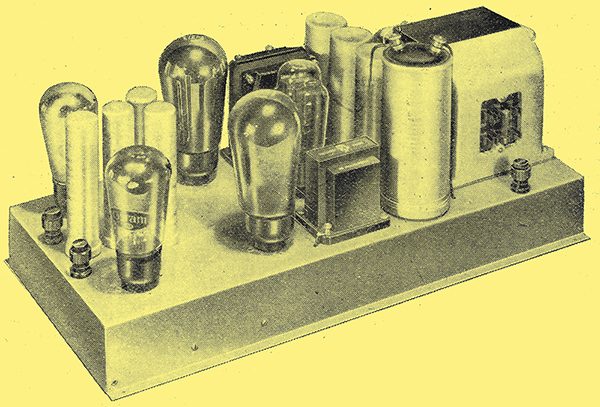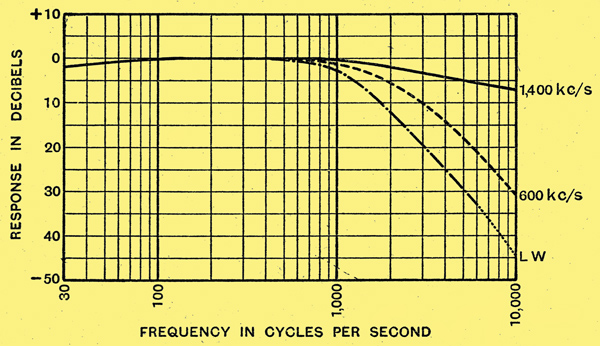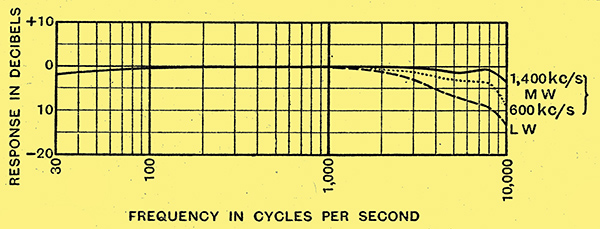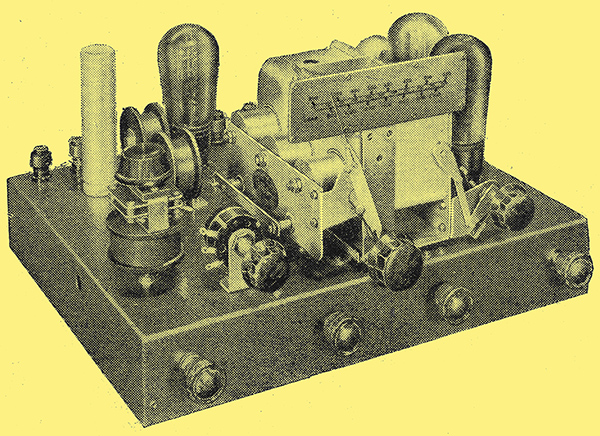|
The design of a receiver, as distinct from a low-frequency amplifier, for the highest quality of reproduction is a matter which is greatly complicated by questions of selectivity and interference. The essential requirements are discussed in this article, and it is shown that, except in local reception, some restriction of the high-frequency response is necessary.

The Push-pull Quality Amplifier, embodying resistance coupling throughout.
It is now nearly a year since The Wireless World Push-Pull Quality Amplifier was described - an amplifier which can truly be said to be perfect so far as sound reproduction is concerned. For outputs up to 4 Watts the amplitude distortion is negligible, over the whole range of audible frequencies the departure from even amplification is so -small that it cannot be detected by ear, and the hum level is below audibility. As originally described, the amplifier was most readily available for gramophone reproduction, but it is equally suitable for use on broadcasting, and several articles have appeared dealing with this aspect, while the modifications necessary to a particular set - the Single-Span Receiver [★] The Wireless World, June 22, 1934. given in full.
That the discriminating listener can appreciate high-quality apparatus is thoroughly proved by the reception accorded to this amplifier and by the steady and insistent demand for a receiver worthy of being coupled with it. As regards freedom from distortion, the modified Single-Span Receiver meets all requirements, and can hardly be improved upon, but the frequency response is rather too good for present-day broadcasting conditions. Moreover, many people feel that the superheterodyne principle is only justified in a long-distance receiver. It was decided, therefore, that a three-stage receiver feeding the amplifier would give performance meeting the requirements of most users of the amplifier, but it was realised that a conventional design would not be satisfactory from the point of view of quality.
Since the amplifier is practically perfect, we need only consider here the receiver which is to feed it, and for a close approach to perfection in quality we require a minimum of amplitude distortion and an overall frequency response flat within very few decibels between 30 Hz and 10 kHz. It is quite possible to attain this, but, paradoxical as it may seem, experience shows that the full frequency response may actually be undesirable on account of interference. Broadcasting stations are, in general, spaced by 9 kHz, which means that if the overall frequency response of the receiver extends as high as 9 kHz an audible note of this frequency will be imposed on the desired programme. Nothing can be done in the receiver, save to use directional aerials, to eliminate such a whistle without also affecting the quality of reproduction by restricting the upper register.
If two adjacent stations are of equal field strength at the receiver the heterodyne note between them will be reproduced at the same strength as a 9 kHz note in the desired programme with a modulation depth of 50%. Such deep modulation rarely occurs in practice tor notes of high frequency, so that the whistle will actually be louder than similar frequencies in the wanted transmission. It is easy to see, therefore, that reproduction up to 9 kHz cannot be tolerated under these conditions, Which apply to the general case of distant reception.
Heterodyne Interference
Now if the field strength of the wanted station is greater than that of its neighbour the strength of the whistle is reduced, and it the disparity in field strength be great enough it will fall below the level of audibility and no longer trouble us. The exact degree of disparity naturally depends upon the volume level, and increases with volume, but is probably about 60 db, or a field strength ratio of 1000:1. Only under such conditions can the full range of musical frequencies be reproduced Without any interference.
In local reception during daylight such a ratio is often naturally present and no difficulty is attached to the attainment of the highest quality. At night, however, the field strength of distant transmissions greatly increases, with the result that at such a short distance as ten miles from a local station the 9 kc/s -whistle may become audible, although it is never very loud.
If these facts be borne in mind it is easy to see that the frequency response of the receiver must be variable within certain limits. It should extend to 10 kHz or beyond to enable the highest standard of quality to be obtained under suitable conditions, but one should be able to limit it to about 8 kHz at will to avoid interference under poorer conditions. If the receiver is to be employed for distant reception to any great extent the response must be curtailed at a lower frequency in order to avoid sideband splash.
Now, in designing any receiver, the problem of the superheterodyne versus the straight set is one which must be settled very early. The superheterodyne principle has quite an undeserved reputation for causing distortion, and many refuse to consider it when high quality is required. This is no doubt due to the fact that many superheterodynes do introduce distortion, but the fact that some examples give poor, quality is no reason for condemning the principle. Actually, it is not difficult to show that, from the point of view of quality, the superheterodyne, and particularly that version of it known as single-span, is inherently better than the ordinary straight set!
Up to the present tuning has almost invariably been carried out in straight sets by means of variable capacitors. It is easy to show that this results in the selectivity varying with the wavelength to which the set is tuned - being greater the longer the wavelength - and the extent of the variation increasing with the efficiency of the tuned circuits. As a consequence, the sideband cutting is greater at long wavelengths than at short, and the high-frequency response poorer. In order to ascertain the extent of this effect in practice a receiver was built which comprised two HF stages using pentode-type valves and a diode detector followed by a triode phase-reversing valve to feed the amplifier. Three tuned circuits were employed using good-quality Litz-wound air-core screened coils of standard commercial design and tuned by a three-gang capacitor. From the points of view of sensitivity and selectivity the set was very satisfactory, but it failed in the matter of quality. Measurement showed the response at 10 kHz to be -7.0 db at 1,400 kHz and -31.0 db. at 600 kHz, while on the long waveband at 150 kHz it was too great to measure accurately, but it was estimated at -45.0 db! The actual fidelity curves obtained are shown in Fig. 1.

Fig. 1. - The fidelity curves of an experimental receiver embodying variable capacitor tuning show how greatly the quality of reproduction varies over the tuning range.
This effect does not occur to the same extent in the superheterodyne because selectivity is obtained in the fixed IF amplifier, and the signal-frequency circuits can be fairly flatly tuned. It is non-existent in the single-span receiver because there are no tuned signal-frequency circuits. The use of the superheterodyne principle hardly seems justified in a receiver intended chiefly for local station reception, however, but, in view of the serious defect of the straight set described above, it would have been necessary if a new development in tuning had not taken place.
It can be shown that it tuning be carried out by means of a variable inductance instead of a variable capacitor, and it the ratio of inductance to effective HF resistance be a constant, then the selectivity, and hence the quality of reproduction, is not affected by the wavelength to which the receiver is tuned. A variable inductance of the requisite type has only recently been produced, and, since the variation is obtained by altering the position of an iron core relative to the winding, it is known as a permeability tuner.
It the constant selectivity obtainable with such a tuning system is to be retained in practice, it is necessary for it to be correctly used, and this involved much research. The commercial example of the unit which was available was provided with small coupling coils, but these were found to be unsatisfactory, and a mathematical investigation showed that under normal conditions only capacity couplings should be used with permeability tuning. Transformer coupling is definitely wrong unless the windings are so arranged that the ratio of tuning coil-inductance to mutual inductance is a constant.
Having obtained a tuning system giving approximately constant selectivity, and found out how to use it, the next step was to decide upon the type of HF amplifier. Many arrangements were tried out and found unsatisfactory, including both one and two stages of amplification with screen-grid type valves. With two HF stages the usual difficulties from instability were found, and even with one valve only symptoms of incipient instability were present. In ordinary receivers these symptoms would be of little moment, for a slight tendency to instability merely means that the amplification and selectivity are increased somewhat. The increase in selectivity, however, is not constant, but varies with wavelength, thus tending to destroy the advantages of the tuner. Of much greater importance,however, is the fact that the feed-back would be most unlikely to be the same in different sets. Depending as it does upon the exact positions of the various components and connecting wires and upon the precise values of the components themselves, the feed-back would vary greatly from receiver to receiver, and the selectivity, and hence the quality, would vary in like manner. Thus, although no difficulty was found in obtaining good results by ordinary methods, it was felt that the possibility of reproducing them in different sets was too small, and the screen-grid valve was abandoned in favour of a system which is inherently stable.

Fig. 2. - When permeability tuning is employed the fidelity becomes much less variable; on the medium waveband the changes are so small that it is difficult to detect them aurally.
It was recently pointed out in this journal [★] The Wireless World, January 18, 1935 that if two triodes be employed instead of a screen-grid valve for each stage of amplification, both the stability and linearity are much greater, and the grid valve that its use was decided upon. The fidelity characteristics of the receiver under these conditions are shown in Fig. 2, and the great improvement in constancy is very evident and is to be attributed to the adoption of permeability tuning.
Various details of design which need not be described here demanded attention, and when these points had been satisfactorily settled the receiver was found to have a sensitivity of the order of 1,000 μV. A moderate degree of tone correction was included to compensate for the small but essentially constant amount of side-band cutting, and a whistle suppressor was added to permit the removal of heterodyne notes.
This proved a very necessary feature, and many arrangements had to be tried before one was found which would effectively remove the interference without greatly affecting the quality of reproduction.
Before concluding, it may be remarked that the receiver is intended chiefly for the reception of the local station and Droitwich, and it is designed to do this with as little distortion of any kind as interference conditions will permit. In addition, however, it will give good reception of many Continental stations at the somewhat lower standard of quality dictated by the greater amount of interference to which they are subject. Under all conditions amplitude distortion is very low at normal volume, for every effort has been made to keep it as small as possible at the present stage of the art.

The receiver chassis, showing the permeability tuner and whistle suppressor.
|